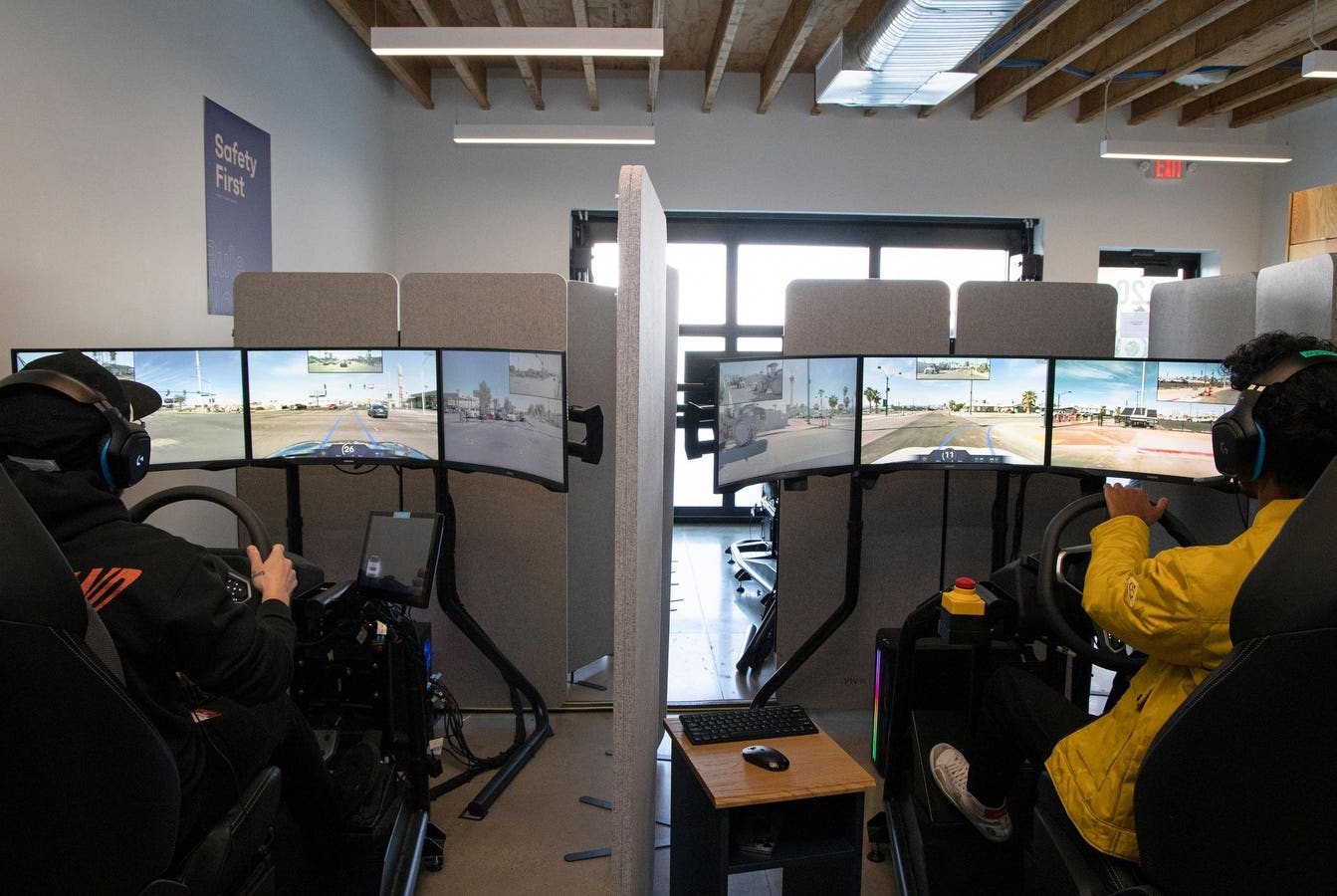Remote driving room at Vay, where operators have video game consoles and multiple screens to control … More
With Tesla now planning to launch its pilot robotaxi service in Austin TX this week using safety drivers (Tesla employees in the passenger seat able to supervise and intervene) it’s a good time to review the history of the safety driver and all the other technologies being used to help self-driving cars deal with the “long tail” of problems they must solve to work on our roads.
Making a car that can handle every possible road situation with perfect safety is a science fictional goal–nobody is close to knowing how to do it. As such, all robocars call on humans in one way or another, from tasks as simple as cleaning and recharging them to intervening when they make an unsafe move. I’ll look at all approaches.
Removing the safety driver is the “big hard step” that changes a vehicle from a testing prototype to a real robotaxi. There are many other steps, but they are baby steps compared to the first time the vehicle goes out without a human overseeing it and able to take control.
Safety Driver
The very first robocars, which were pretty primitive and failed often, were set up so a human driver could sit in the driver’s seat and grab the wheel or press the pedals at any time. That immediately disengaged the self-drive system and the car became manually driven. Many cars also had the “big red button,” an emergency stop button to be used if grabbing the controls failed. It usually did a hard disconnect of all systems, but in practice most are never used.
Outside of closed courses like the DARPA Grand Challenge, all robocar testing from day one has worked this way. All teams hope for the day they can remove that safety driver, as that is the whole goal. It generally works well. With properly behaving safety drivers, test robocars have very good safety records. Except for one giant black mark, when Uber ATG did not manage safety drivers well, and hired one who watched a TV show instead of doing her job, allowing the vehicle, when it failed (as prototypes are expected to do) to strike and kill a pedestrian.
In the early years, cars typically had two staff in them, one behind the wheel, and the other, sometimes called the software operator, who monitored the driving soft
ware to make sure it was doing the right things. Safety drivers can take the wheel at any time, and are told to do it if they feel anything odd is going on, or sometimes if a risky situation is likely. Especially in early years, if there were children on the street, you always took over. In addition, if the software detected any problems, it would alert the safety driver to take over.
Teams (and governments) track interventions. The best teams take every significant intervention and create a simulation scenario to duplicate it, then test what would have happened if the human had not intervened. If the car would have done something bad, like hit something, that becomes a priority problem to fix. Indeed, interventions where it turns out the car would have done fine are often not even counted.
Tesla took things to a new level when it released Autopilot and FSD. These had ordinary untrained customers act as supervisor for the vehicle. Google/Waymo had only used trained employees who took a driving safety course. When Tesla did this, there was great skepticism that relying on ordinary customers would be unsafe, but in reality, it worked out. Probably not as safe as ordinary driving, but fairly similar. (Tesla misleadingly claims it is much safer, but this is false.)
Safety Driver not in Driver’s Seat
The normal place is behind the wheel, but some vehicles put a safety operator in another location, such as the passenger’s seat. In vehicles designed with no controls (like some shuttles) the employee may have access to just an emergency stop button that commands the vehicle to stop and pull over, or slightly more involved controls. This may also include a video game controller, wheel or gamepad that can be plugged in for manual driving.
This is probably not as safe as a person behind the wheel. In the passenger’s seat, there is a ong history of human driving instructors training teen drivers by having their own brake pedal and the ability to grab the wheel. I remember my own driving instructor doing that. It works, though it’s not clear if it has any purpose other than saying, “nobody at the wheel.” It’s more for PR than safety in vehicles that still have a wheel.
Even so, some companies have done it. Russian robotaxi company Yandex used it in Austin and other cities. (Yandex is now non-Russian and called AVRide.) Cruise did their first “driverless” test with an employee in the passenger seat. Most shuttle companies keep a worker in the shuttle who can hit the emergency stop, and pull out a game controller to drive.
Remote Driving
It may surprise some to learn there are remotely driven cars on the road today. German company Vay uses this to deliver cars to customers in Las Vegas. Several other companies have built different tools for remote driving. I worked (with compensation) with one such company, DriveU.Auto to produce a video about some of these approaches.
Remote driving is done over public data networks, which of course face interruptions and packet loss and sometimes long latency. As such, it is typically done with a system capable of doing safe basic operations without remote input so that it will, at worst case, just come to a stop if comms get too bad. They are also usually designed to use multiple communications channels to survive problems with any one of them.
Remote driving still requires paying a human, so you lose a lot of the cost advantage of a robocar over say, an Uber. However, you don’t have to pay a human while the vehicle is sitting waiting. (Uber doesn’t pay its drivers for that either, but it effectively builds into the fares for actual driving enough to make drivers tolerate the wait. They can also do other work or read or watch videos between rides.) As such, it can be cheaper to operate a remote driven fleet than a human driven one, and you can do WhistleCar service (car delivery) like Vay.
Some companies, like Waymo, make use of low speed remote driving when they are in a situation where they want to move a stuck car or solve a problem the software can’t. At these low speeds, you can’t do much damage and you can stop on a dime if the connection has an issue.
Some delivery robots, such as the early Kiwibot and Coco, were entirely remote driven, because at the speed of sidewalk delivery robots, that’s fairy doable without safety concerns. (Indeed, many of these robots are so light that they don’t hurt people even if they did hit them.)
Tesla has advertised for programmers for some time to work on their remote driving and control systems for both robotaxis and the Optimus robot.
Remote Supervision with Driving
Remote supervision is effectively taking the safety driver and making them remote. The car mostly drives itself, but the remote supervisor is always watching (usually with an array of screens or possibly a VR headset) and “grabs the wheel” virtually if they see the need to take over. You need to not need “instant” takeovers that depend on sub-second reaction times (humans need about 0.7 seconds even when in the car) but is good for most problems which are apparent further in advance when you have the power of a human mind. This approach is not used by any team, at least publicly, though it has been speculated that Tesla is considering it.
Remote Monitoring with Stop
Most companies have the ability to connect to a car and watch what it’s doing, even in full autonomous mode. Companies decline to comment on this, but all of them probably did this when they first dared to send the cars out with no safety driver. It seems like it would be foolish not to. Full time 1:1 remote monitoring doesn’t scale very well, but it makes perfect sense in a pilot. In addition, these remote monitors probably have some ability to send a “kill” command to the vehicle, to ask it to immediately stop and pull over, known as a “minimum risk condition.” The difference between this and remote supervision is that these remote monitors can’t do live steering, just hard stopping. Once stopped, however, they can usually switch into remote assist mode.
Remote Assist
All companies tend to have a remote assist operations room. There, operators are present who can help vehicles solve problems when they get confused. They usually cannot drive the vehicles directly, only give them strategic advice, like “Turn around and take this new route” or “Make the 2nd left” or “Follow this set of waypoints to get around that obstacle” and most often “Continue with your current plan, it’s OK.”
For remote assist to scale, you need to have many more vehicles on the road than remote assist operators, so that each vehicle on average needs active assist just a small fraction of the time. At Starship technologies, a delivery robot company, we set a goal of having 99% autonomy, meaning 100 robots for each operator. This makes the human labor cost effective. It’s easier to do for delivery robots which can just stop and wait at any time. A leak from Cruise revealed robots were asking for help about every 5 minutes, which Cruise CEO Kyle Vogt felt was according to plan during their pilot stage. Over time the numbers would get better, but are never expected to get to zero. In most cases, according to Cruise, all the remote operator does is say, “yes, continue with your plan A.” (In a typical remote assist, the vehicle sees a situation it is not fully sure of and offers multiple plans to the human remote operator, who picks one, or just allows plan A, or rarely crafts a new plan.)
Sometimes remote operators will make human-like mistakes, which has been responsible for some strange incidents at Waymo, including one crash when the remote operator approved the vehicle going when it should not have.
Some companies do have remote operators watching multiple cars at a time, which humans can do. While this may not scale long term, it’s reasonably affordable today and wise during the pilot and growth stages of a robotaxi fleet.
Waymo recently added the ability of remote operators to do low-speed remote drive to do things like move cars off the road, or out of trouble situations like blocked streets and emergency vehicles.
Rescue Driver
When all else fails, most teams can send humans in a car to rescue a vehicle by manually driving it, or in the worst case, towing it. For cars without controls, these teams will have a plug-in video game style controller. There are reports that some cars also have such a controller locked in a compartment that law enforcement can open so they can move cars without controls.









